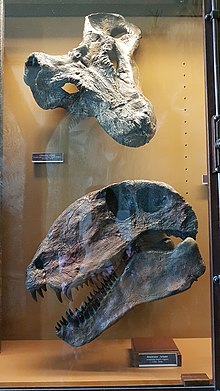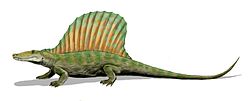| Sphenacodontoids Temporal range: Late Carboniferous-Recent, | |
|---|---|
 | |
| Fossilized skull of two sphenacodontoids: Clelandina (Therapsida, Gorgonopsidae) and a Dimetrodon (Sphenacodontidae). | |
| Scientific classification | |
| Domain: | Eukaryota |
| Kingdom: | Animalia |
| Phylum: | Chordata |
| Clade: | Synapsida |
| Clade: | Sphenacomorpha |
| Clade: | Sphenacodontia |
| Clade: | Pantherapsida |
| Clade: | Sphenacodontoidea Marsh, 1878 |
| Clades | |
Sphenacodontoidea is a node-based clade that is defined to include the most recent common ancestor of Sphenacodontidae and Therapsida and its descendants (including mammals). [1] Sphenacodontoids are characterised by a number of synapomorphies concerning proportions of the bones of the skull and the teeth. [2] [3]
Contents
The sphenacodontoids evolved from earlier sphenacodonts such as Haptodus and Ianthodon via a number of transitional stages of small, 1-10 kg, faunivore animals. [1] The possible common ancestor of sphenacodontids and therapsids was a carnivorous synapsid that reached moderate or large size and more closely resembled the land-dominant Early Permian sphenacodontids than the small Haptodus. [2] The first predators among Sphenacodontoidea, like Shashajaia , appeared in the tropical western part of Pangea in the Late Carboniferous. [1] Later, in Permian, sphenacodontoids gave rise to the dominant terrestrial carnivores in both sphenacodontid and therapsid groups. [2]





